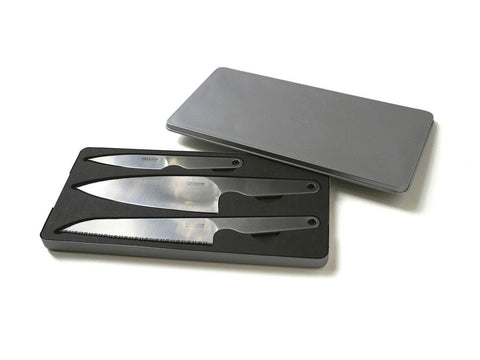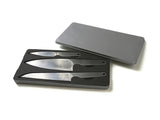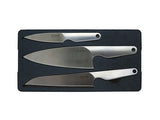This is a compact set of three professional quality cooking knives made from Sandvik 12C27 Swedish Stainless Steel that are optimized specifically for travel; more lightweight, more compact and easier to clean. The Field Knife Set was designed specifically for outdoor and travel use. They are therefore much more compact than standard kitchen knives. In order to achieve this, the traditional grip has been reduced to a bare minimum of what is necessary.
The Field Knife Set consists of three of the most commonly used kitchen knives: a small paring knife, a serrated knife, and a compact chef’s knife, all packaged inside a thin, travel-friendly aluminum case, sandwiched between two Richlite cutting boards. One cutting board has cut-outs for the knives to fit inside and the other one lays on top. The dimensions of the complete set inside packaging is approximately: 11” (276mm) x 5.4” (136mm) x 0.56” (14mm).
The Paring Field Knife is design to be very compact and lightweight. It has a 3.5” (89MM) blade length with a total length of 6.85” (174MM) and a total weight of just 1.2oz (35 grams).
The Serrated Field Knife is designed to be very compact and lightweight. It has a 6.1” (155MM) blade length with a total length of 10” (254MM) and a total weight of just 2.5oz (70 grams).
The Chef’s Field Knife is designed to be very compact and lightweight with a shorter blade that allows for greater control and efficiency. It has a 6.25” (159MM) blade length with a total length of length of 10” (256MM) and a total weight of just 3.5oz (100 grams).
So why doesn’t the Field Knife design have a grip? The short answer is that if a kitchen knife is held correctly, in the manner that most Chef’s hold a kitchen knife, you are much less reliant on the grip itself.
Most people have a tendency to hold a Chef’s Knife in what is generally referred to as the hammer grip. The hammer grip is great when you need to have a firm grip and apply great force, such as carving wood or fighting a bear. It is, however, not the best way to hold a Chef’s Knife. The hammer grip reduces control on a tall Chef's knife and creates fatigue during extended use.
Chefs on the other hand use what is called ‘the professional grip’. To hold your knife in a professional grip, start by pinching the knife blade where it transitions into the handle, between your thumb and index finger. Some people will pinch with the index, middle finger and thumb. Either way will work. Next, slip your middle finger (if you’re doing a single finger grip), or ring finger (if you’re using a two finger grip) up behind the bolster of the knife. The bolster is the vertical piece of blade that connects to the handle.
Continue by lightly wrapping the rest of your fingers around the handle of the knife. These fingers are more for support; the focus of the grip should be on pinching the blade. Keep your grip nice and loose. Gripping your knife too tightly will lead to excess tension in your hand, wearing you out quickly and affecting the accuracy of your cuts. The proper way to hold a kitchen knife is surprisingly easy once you get used to it and it will make using your kitchen knife a much more enjoyable experience.
For cutting softer products, such as vegetables, meat and fish, you rely less on the grip because chopping and dicing require flexibility and a loose, relaxed grip so that the knife can pivot.
Richlite is made in the USA with a high-quality, NSF (National Sanitary Foundation) - certified wood fiber composite. This nonporous food preparation surface does not harbor bacteria and is dishwasher safe. It is knife friendly, heat and stain resistant and virtually maintenance free.








